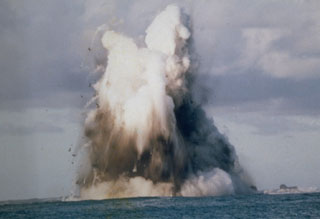Report on Nishinoshima (Japan) — 30 August-5 September 2017
Smithsonian Institution / US Geological Survey
Weekly Volcanic Activity Report, 30 August-5 September 2017
Managing Editor: Sally Sennert.
Please cite this report as:
Global Volcanism Program, 2017. Report on Nishinoshima (Japan) (Sennert, S, ed.). Weekly Volcanic Activity Report, 30 August-5 September 2017. Smithsonian Institution and US Geological Survey.
Nishinoshima
Japan
27.247°N, 140.874°E; summit elev. 100 m
All times are local (unless otherwise noted)
The Japan Coast Guard reported that visual observations of Nishinoshima from an aircraft during the afternoon of 11 August suggested that the eruption was continuing; a high temperature area at the ocean entry on the W flank and a steam plume indicated flowing lava. Lava in the central crater could not be confirmed; a small fumarolic emission rose from the crater’s edge. Observations on the afternoon of 24 August suggested no lava flowing into the ocean.
Geological Summary. The small island of Nishinoshima was enlarged when several new islands coalesced during an eruption in 1973-74. Multiple eruptions that began in 2013 completely covered the previous exposed surface and continued to enlarge the island. The island is the summit of a massive submarine volcano that has prominent peaks to the S, W, and NE. The summit of the southern cone rises to within 214 m of the ocean surface 9 km SSE.
Source: Japan Coast Guard

